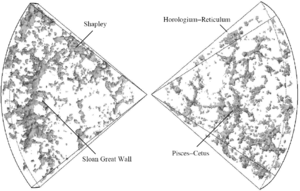Sloan Great Wall

The Sloan Great Wall, a giant wall of galaxies, is the largest known structure in the Universe. Its discovery was announced on October 20, 2003 by J. Richard Gott III and Mario Juric, of Princeton University in the USA, and their colleagues. The Wall was found using data from the Sloan Digital Sky Survey[1]. The structure measures 1.37 billion light years in length (over 8 sextillion miles) and is approximately one billion light-years away.
The Sloan Great Wall is nearly three times longer than the Great Wall of galaxies, the previous record-holder, which was discovered by Margaret Geller and John Huchra of Harvard in 1989. Astronomers point out that technically, the Sloan Great Wall is not a 'structure'. As described by PhD student Jane Tang, "Structure usually means that the components are gravitationally related with each other. For example, the solar system is a structure because the Earth is rotating around the Sun because of the gravity of the sun. The galaxies in that structure are gravitationally involved and might evolve to galaxy clusters later on. But the Sloan Great Wall is not a structure. That is an artificial view caused by the distance measurement that they used."[2] Thus, the filament structure[3] discovered with the Subaru Telescope in July 2006 is the largest known 'structure' in the Universe, despite being considerably smaller than the Sloan Great Wall.
The Sloan Great Wall should not be confused with the Great Wall of China, which is only approximately 4,000 km in length. It would take 250,000,000,000,000,000 (or 2.5 * 1017) of these walls to approximately match the length of the Sloan Great Wall.
References
- ^ J. R. Gott III et al., Astrophys. J., 624, 463 (2005). Figure 8 – "Logarithmic Maps of the Universe" – is available as a poster from the homepage of Mario Juric.
- ^ http://experts.about.com/q/Astronomy-1360/Biggest-Thing-Universe.htm
- ^ http://www.spacedaily.com/reports/Subaru_Telescope_Spots_Largest_Structure_In_The_Universe_999.html
